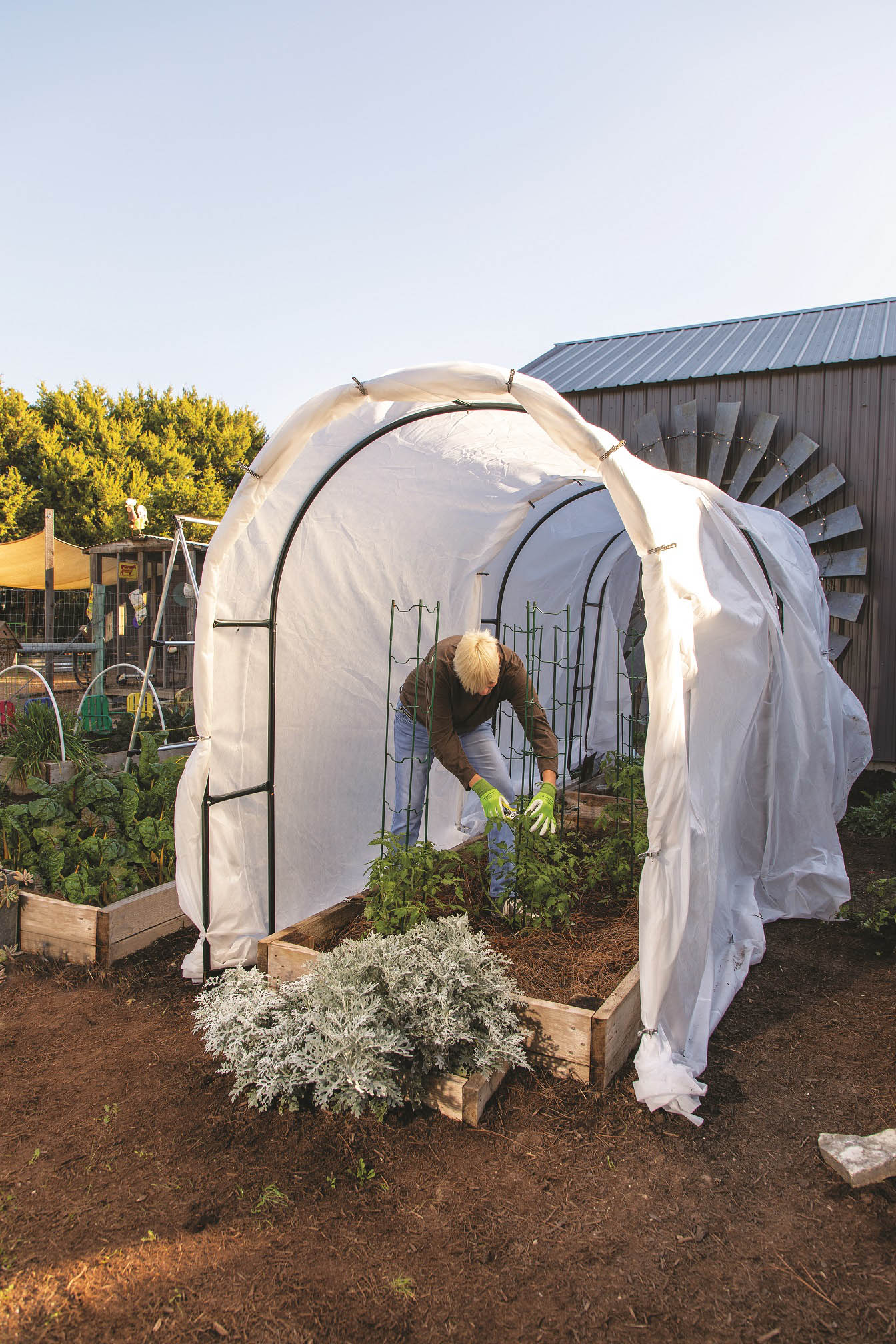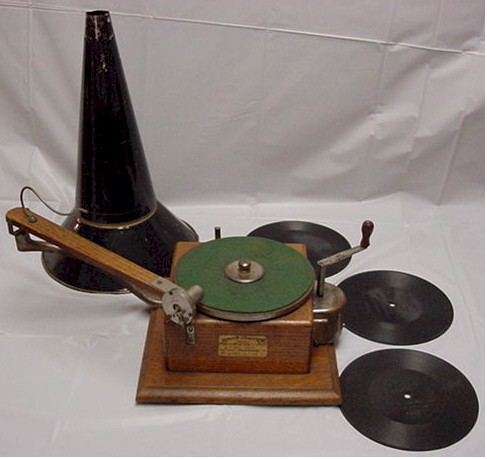
Gardening
Keep Gardening After the First Fall Frost

High tunnel systems with hoops and row covers work well on garden beds filled with large plants, allowing easy access for harvesting while protecting the plants.
Photo credit: Photo courtesy of Gardener's Supply Company
There is nothing worse than frost in the forecast and a garden full of vegetables not quite ready for picking. Use some simple strategies to extend the growing season and keep enjoying garden-fresh vegetables.
Fortunately, some vegetables like cabbage, broccoli, cauliflower, kale, and Brussels sprouts tolerate frost and even taste better after a slight chill. Most of these can tolerate temperatures as low as 24 to 28 degrees F.
Leeks are another vegetable that thrive in cooler temperatures. Many tolerate temperatures as low as 20 degrees F. Just mound some protective mulch around the plants and continue harvesting. Leave some of your carrots, turnips, and parsnips in the ground for winter. Just cover the soil with straw or evergreen boughs after it lightly freezes. Dig as needed or during a winter thaw. You will enjoy their wonderfully sweet flavor.
Protect frost-sensitive plants with old bed sheets and even mattress pads. Cover the plants in late afternoon and remove them as soon as the temperatures climb above freezing. Keep them handy and be ready to cover whenever frost is in the forecast.
Make it easier by using all-purpose garden fabric row covers. This spun material allows air, light, and water through while protecting the plants from frost. Loosely cover the plants and anchor the edges with stones, boards, or garden pins. You only need to remove the fabric to harvest ripe vegetables. Otherwise, it can stay in place until the vegetables stop producing or you decide it is time to end the season.
Create a high tunnel over garden beds filled with large plants. Use hoops and row covers to allow easy access for harvesting while protecting the plants. Systems like Maxi Garden Hoops stand seven feet tall and five feet wide when installed. Simply cover the set of three hoops with row cover fabric.
Cloches have long been used to jump start the season or extend it beyond the first fall frost. You will find a variety of shapes and sizes available. Select one large enough to cover your plants and protect them as needed. Look for those with vents to prevent plants from overheating and ones like the cool weather row cloches (gardeners.com) that allow water through while trapping in the heat.
Don't let unripe tomatoes go to waste if you are unable or unwilling to protect them from frost. Harvest any that are starting to show color before the killing frost and finish ripening them indoors. The bottom of the tomato should be greenish white or starting to color up. Store your green tomatoes in a cool (60 to 65 degrees) location to extend their storage life.
Spread the tomatoes out on heavy paper or wrap them individually in newspaper so the fruit do not touch. They will ripen over the next few weeks. Speed up the process by moving a few tomatoes to a warm, bright location a few days before they are needed. Enjoy green tomatoes fried, in relish, salsa, pies or one of many more ways.
And when the season finally ends for you, start planning for next year. Many of these same strategies can be used to jump start the season for an earlier harvest.
Melinda Myers is the author of more than 20 gardening books, including Small Space Gardening. She hosts The Great Courses "How to Grow Anything" DVD series and the Melinda's Garden Moment TV & radio segments. Myers is a columnist and contributing editor for Birds & Blooms magazine. Her web site is www.MelindaMyers.com.
Antiques
Some of My Best Estate Finds

People often ask me "what's the most interesting or valuable item you've sold?" After selling antiques and collectibles for over 30 years and running auctions for over 20, there are plenty of items that come to mind.
One of the first estates I handled after starting my auction business was full of treasures that were literally buried. The estate belonged to a doctor who served as an officer during World War II. He held on to many things throughout his lifetime, including newspapers and magazines. His newspapers covered many valuable items that were hidden beneath.
However, there were larger items that were clearly visible when I first walked through the home. There were marble-top Victorian tables as well as other Victorian era furniture. Furniture sold much better 20 years ago than it does now, and we sold marble-top tables from the estate for around $400 then. Two fireplace mantles that were also from the Victorian era sold for just under $1,000 each. There were five or six stacking bookcases that brought around $200 per stack at auction then.
I had to dig a bit deeper for other smaller valuable pieces. I found a wooden folding camera in a purple velvet lined box brought a little over $1,000 at auction. A bookcase held a small bud vase marked "LCT." The approximately 6" vase was a "pulled feather pattern" by Louis Comfort Tiffany and sold for close to $1,000 at auction.
The doctor whose estate I was handling had served in the South Pacific during World War II and had many photographic negatives from his time in the service as well as other times during his life, including photos and negatives from the 1939 New York World's Fair. These photos and negatives sold for well over $1,000 when split into several lots.
There were also some paintings in the estate, including one by Impressionist painter Joseph H. Greenwood of Spencer, MA. According to a Worcester Art Museum biography, Greenwood "left school at age 11 to work in the local boot factory and later wire mill. Meanwhile, he scavenged chicken feathers for brushes and wallpaper scraps for pigment to create his first works of art." A wealthy mill owner recognized his artistic talent and paid for two terms of study for Greenwood at Wilbraham Academy. Greenwood made a living painting local landscapes. The Greenwood painting I found in this estate had been damaged, but still sold for over $2,000.
A collection of phonographs was the most valuable find. There were Edison cylinder players that were selling in the $300 to $500 range at the time. A metal sign advertising Edison records picturing Thomas Edison sold for nearly $1,000. But the best find was a Berliner gramophone. Emile Berliner manufactured phonographs that played discs in competition with Edison's cylinder players. The Berliner gramophone hit a high note with bidders when it sold for over $5,000 at one of our auctions.
Our current online model railroad and die-cast car auction ends on September 22nd. Our online estate auction with 1950s and 1960s Corvettes, boat motors, tools and other estate items will be open for bidding by September 22nd. I'll be teaching my "Evaluating your antiques" night class November 10th at Bay Path Evening School in Charlton and on November 13th I'll also be appraising items virtually for the Townsend, MA Historical Society. Please visit our website for more details on upcoming events: www.centralmassauctions.com.
Contact us at: Wayne Tuiskula Auctioneer/Appraiser Central Mass Auctions for Antique Auctions, Estate Sales and Appraisal Services www.centralmassauctions.com (508-612- 6111) info@centralmassauctions.com